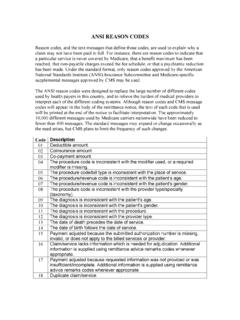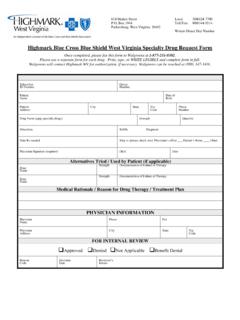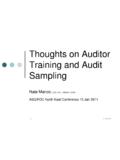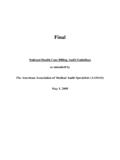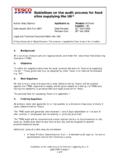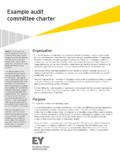Transcription of E/M DOCUMENTATION AUDITORS’ WORKSHEET …
1 E/M DOCUMENTATION auditors WORKSHEET 1995 guidelines Member Last Name or Identifying Number _____ Provider Name _____ Date of Service _____ Procedure Code(s) Reported _____ Auditor Agrees Auditor Disagrees Code Assigned by Auditor _____ Record Audited by Date E/M DOCUMENTATION auditors Instructions Refer to data section (table below) in order to quantify. After referring to data, circle the entry to the RIGHT in the table, which best describes the HPI, ROS and PFSH. If one column contains three circles, draw a line down that column to the bottom row to identify the type of history. If no column contains three circles, the column containing a circle farthest to the LEFT, identifies the type of history. Chief Complaint:_____ History Recorded by:_____ After completing this table which classifies the history, circle the type of history within the appropriate grid in Section 5 H I S T O R Y Status of 3 Chronic Conditions is not available within the context of 1995 guidelines HPI (history of present illness) elements: Location Severity Timing Modifying factors Quality Duration Context Associated signs and symptoms Brief (1-3) Brief (1-3) Extended (4 or more) Extended (4 or more) ROS (review of systems).
2 Constitutional (wt loss, etc) All others negative Eyes Ears, nose, mouth, throat Endocrine Musculoskeletal Cardiovascular Genitourinary Neurological Gastrointestinal Hematological/Lymph Psychological Integumentary Respiratory Allergy/Immuno None Pertinent to Problem (1 system) Extended (2-9 Systems) **Complete PFSH (past medical, family, social history) areas: Past history ( the patient s past experiences with illnesses, operation, injuries and treatments) Family history (a review of medical events in the patient s family, including diseases which may be hereditary or place the patient at risk) Social history (an age appropriate review of past and current activities) None None Pertinent (1or 2 history areas) Complete* (2 or 3 history areas) HISTORY FOCUSED Detailed COMPREHENSIVE *Complete PFSH: 2 history areas: a) Established patients office (outpatient) care, domiciliary care, home care b) Emergency department; c) Subsequent nursing facility care; d) Subsequent hospital care 3 history areas: a) New patients office (outpatient) care, domiciliary care, home care; b) Initial consultations; c) Initial hospital care.
3 D) Hospital observation; and, e) Comprehensive nursing facility assessments. ** 10 or more systems, or some systems with statement all others negative Refer to data section (table below) in order to quantify. After referring to data, identify the type of examination. Circle the type of examination within the appropriate grid in Section 5. Limited to affected body area or organ system (one body area or system related to problem) PROBLEM FOCUSED EXAM Affected body area or organ system and other symptomatic or related organ system(s) (additional systems) EXPANDED PROBLEM FOCUSED EXAM Extended exam of affected area(s) and other symptomatic or related organ system(s) (additional systems up to total of 7 ( more depth and elaboration than above) DETAILED EXAM General multi-system exam (8 or more systems) or complete exam of a single organ system (Body areas do not count) COMPREHENSIVE EXAM E X A M Body area: Head, including face Chest, including breasts and axillae Abdomen Neck Back, including spine Genitalia, groin, buttocks Each extremity OR Organ systems.
4 Constitutional Ears, nose, Respiratory Musculoskeletal Psych ( , vitals, gen app) mouth, throat Gastrointestinal Skin Hem/lymph/imm Eyes Cardiovascular GU Neuro 1 body area or organ system 2 4 body areas or organ systems 5 7 body areas or organ systems WITH MORE DEPTH 8 or more organ systems or comprehens. single organ system exam PROBLEM FOCUSED FOCUSED DETAILED COMPRE HENSIVE 1. History 2. Examination Exam Score ( ) Number of Diagnoses or Treatment Options Identify each problem or treatment option mentioned in the record. Enter the number in each of the categories in Column B in the table below. ( Maximum number = two categories.) Do not categorize the problem(s) if the encounter is dominated by counseling/coordinating of care, and duration of time is not specified.
5 In that case, enter 3 in the total box. Number of Diagnoses or Treatment Options A B X C = D Problem(s) Status Number Points ResultSelf-limited or Minor (stable, improved or worsening) Max=2 1 Est. problem (to examiner); stable, improved 1 Est. problem (to examiner); worsening 2 New problem (to examiner); no additional workup planned Max=1 3 New prob (to examiner); add workup planned 4 TOTAL Multiply the number in columns B & C and put the product in column D. Enter a total for column D. Bring total to line A in Final Result for Complexity (table below) Amount and/or Complexity of Data Reviewed For each category of reviewed data identified, circle the number in the point s column. Total the points. Amount and/or Complexity of Data Reviewed Reviewed Data Points Review and/or order of clinical lab tests 1 Review and/or order of tests in the radiology section of CPT 1 Review and/or order of tests in the medicine section of CPT 1 Discussion of test results with performing physician 1 Decision to obtain old records and/or obtain history from someone other than patient 1 Review and summarization of old records and/or obtaining history form someone other than patient and/or discussion of case with another health care provider 2 Independent visualization of image, tracing or specimen itself (not simply review of report) 2 TOTAL Bring total to line C in Final Result for Complexity (table below) Use the risk table below as a guide to assign risk factors.
6 It is understood that the table below does not contain all specific instances of medical care, the table is intended to be used as a guide. Circle the most appropriate factor(s) in each category. The overall measure of risk is the highest level circled. Enter the level of risk identified in Final Result for Complexity (table below) Risk of Complications and/or Morbidity or Mortality Level of Risk Presenting Problem(s) Diagnostic Procedure(s) Ordered Management Options Selected Minimal One self-limited or minor problem cold, insect bite, tinea corporis Laboratory tests requiring venipuncture Chest x-rays EKG/EEG Urinalysis Ultrasound, , echo KOH prep Rest Gargles Elastic bandages Superficial dressings Low Two or more self-limited or minor problems One stable chronic illness, well controlled hypertension or non-insulin dependent diabetes, cataract, BPH Acute uncomplicated illness or injury, , cystitis, allergic rhinitis, simple sprain Physiologic tests not under stress, , pulmonary function tests Non-cardiovascular imaging studies with contrast.
7 Barium enema Superficial needle biopsies Clinical laboratory tests requiring arterial puncture Skin biopsies Over the counter drugs Minor surgery with no identified risk factors Physical therapy Occupational therapy IV fluids without additives Moderate One or more chronic illnesses with mild exacerbation, progression, or side effects of treatment Two or more stable chronic illnesses Undiagnosed new problem with uncertain prognosis, , lump in breast Acute illness with systemic symptoms, , pyelonephritis, pneumonitis, colitis Acute complicated injury, , head injury with brief loss of consciousness Physiologic tests under stress, , cardiac stress test, fetal contraction stress test Diagnostic endoscopies with no identified risk factors Deep needle or incisional biopsy Cardiovascular imaging studies with contrast and no identified risk factors, , arteriogram cardiac cath Obtain fluid from body cavity, , lumbar puncture, thoracentesis, culdocentesis Minor surgery with identified risk factors Elective major surgery (open, percutaneous or endoscopic)
8 With no identified risk factors Prescription drug management Therapeutic nuclear medicine IV fluids with additives Closed treatment of fracture or dislocation without manipulation High One or more chronic illnesses with severe exacerbation, progression or side effects of treatment Acute or chronic illnesses or injuries that may pose a threat to life or bodily function, , multiple trauma, acute MI, pulmonary embolus, severe respiratory distress, progressive severe rheumatoid arthritis, psychiatric illness with potential threat to self or others, peritonitis, acute renal failure An abrupt change in neurologic status, , seizure, TIA, weakness or sensory loss Cardiovascular imaging studies with contrast with identified risk factors Cardiac electrophysiological tests Diagnostic endoscopies with identified risk factors Discography Elective major surgery (open, percutaneous or endoscopic with identified risk factors) Emergency major surgery (open, percutaneous or endoscopic) Parenteral controlled substances Drug therapy requiring intensive monitoring for toxicity Decision not to resuscitate or to de-escalate care because of poor prognosis Final Result for Complexity Draw a line down any column with 2 or 3 circles to identify the type of decision making in that column.
9 Otherwise, draw a line down the column with the 2nd circle from the left. After completing this table, which classifies complexity, circle the type of decision making within the appropriate grid in Section 5. Final Result for Complexity A Number diagnoses or treatment options < 1 Minimal 2 Limited 3 Multiple > 4 Extensive B Highest Risk Minimal Low Moderate High C Amount and complexity of data < 1 Minimal or Low 2 Limited 3 Multiple > 4 Extensive Type of decision making STRAIGHT-FORWARD LOW COMPLEX. MODERATE COMPLEX. HIGH COMPLEX. If the physician documents total time and suggests that counseling or coordinating care dominates (more than 50%) the encounter time may determine level of service. DOCUMENTATION may refer to prognosis, differential diagnosis, risks, benefits of treatment, instructions, compliance, risk reduction or discussion with another health care provider. Does DOCUMENTATION reveal total time?
10 Time Face-to-face in outpatient setting Unit/floor in inpatient setting Yes No Does DOCUMENTATION describe the content of counseling or coordinating care? Yes No Does DOCUMENTATION reveal that more than half of the time was counseling or coordinating care? Yes No If all answers are yes , select level based on time. 3. Medical Decision Making CONFIDENTIAL4. Time Outpatient, Consults (OUTPATIENT & INPATIENT) and ER New Office / Consults / ER Established Office Requires 3 components within shaded area Requires 2 components within shaded area History PF ER:PF EPF ER:EPF D ER:EPF C ER: D C ER: C Minimal problem that may PF EPF D C Examination PF ER:PF EPF ER:EPF D ER:EPF C ER: D C ER: C not require presence of PF EPF D C Complexity of medical decision SF ER:SF SF ER:L L ER:M M ER: M H ER: H physician SF L M H Average Time (minutes) (ER has no average time) 10 New (99201 15 Outpt cons (99241) 20 Inpat cons (99251) ER (99281) 20 New (99202) 30 Outpt cons (99242) 40 Inpat cons (99252) ER (99282) 30 New (99203) 40 Outpt cons (99243) 55 Inpat cons (99253) ER (99283) 45 New (99204) 60 Outpt cons (99244) 80 Inpat cons (99254) ER (99285) 60 New (99205) 80 Outpt cons (99245) 110 Inpat cons (99255) ER (99285) 5 (99211) 10 (99212) 15 (99213) 25 (99214) 40 (99215) Level I II III IV V I II III IV V INPATIENT Initial Hospital/Observation Subsequent Inpatient/Follow-up Requires 3 components within shaded area Requires 2 components within shaded area History D or C C C PF interval EPF interval D interval Examination D or C C C PF EPF D Complexity of medical decision SF/L M H SF/L M H Average time (minutes) (Observation care has no average time))
